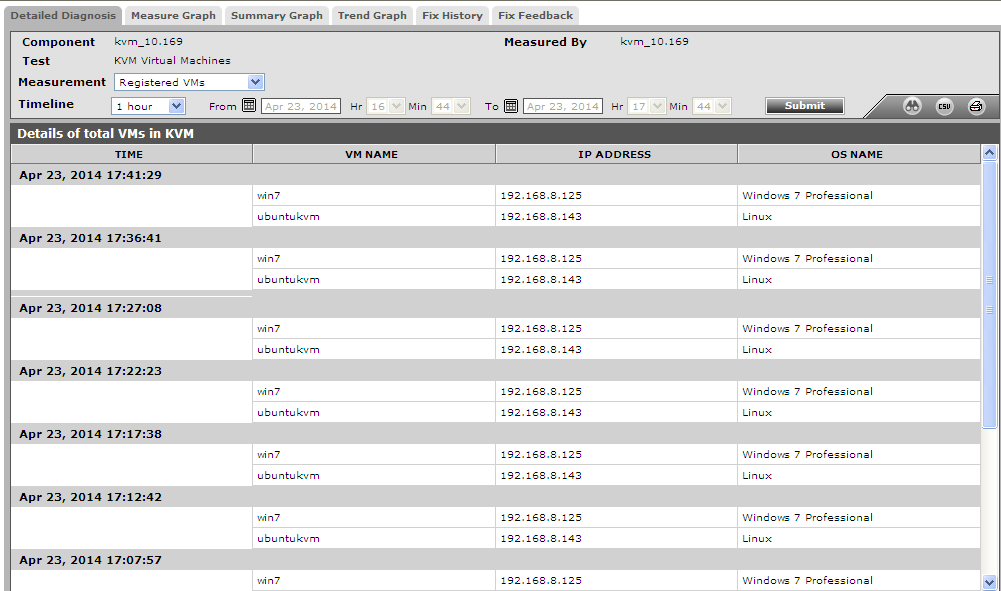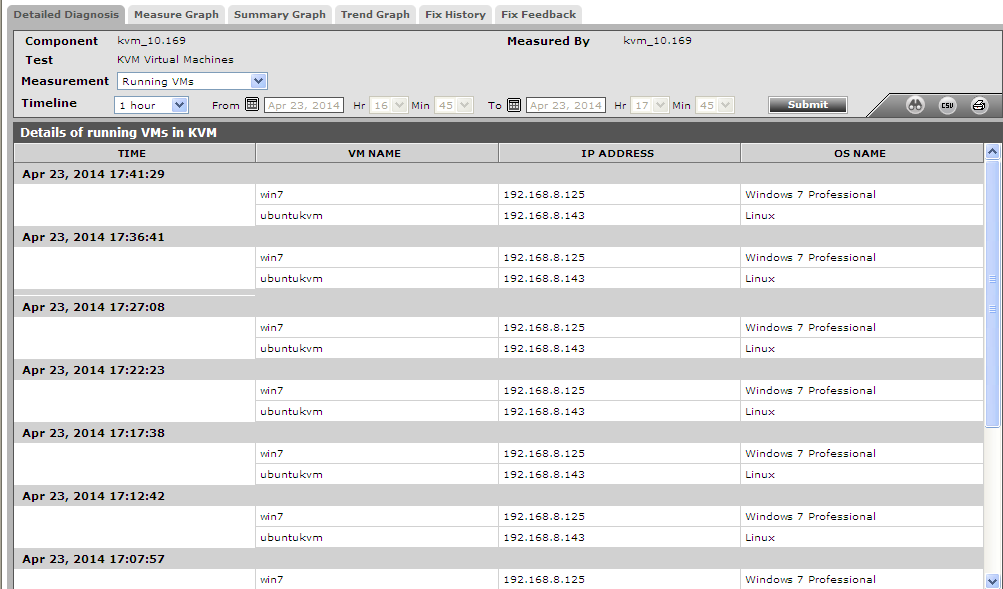KVM Virtual Machines Test
Whenever users complain of inaccessibility of their virtual machines, administrators need to promptly determine the reason for the same - is it because the VMs are not running currently? is it because they are not even registered? or is it because they have been moved to another server? The KVM Virtual Machines test provides administrators with this information. This test tracks the status and movement of each virtual machine on the target KVM server, reports the number and names of virtual machines in various states, and also captures the migration of virtual machines to other servers.
Target of the test : A KVM server
Agent deploying the test : An internal agent
Outputs of the test : One set of results for the KVM server that is to be monitored.
| Parameter | Description |
|---|---|
|
Test Period |
How often should the test be executed. |
|
Host |
The IP address of the host for which this test is to be configured. |
|
Port |
The port at which the specified host listens. |
|
Detailed Diagnosis |
To make diagnosis more efficient and accurate, the eG Enterprise embeds an optional detailed diagnostic capability. With this capability, the eG agents can be configured to run detailed, more elaborate tests as and when specific problems are detected. To enable the detailed diagnosis capability of this test for a particular server, choose the On option. To disable the capability, click on the Off option. The option to selectively enable/disable the detailed diagnosis capability will be available only if the following conditions are fulfilled:
|
| Measurement | Description | Measurement Unit | Interpretation |
|---|---|---|---|
|
Registered VMs |
Indicates the total number of virtual machines that have been registered with this KVM server. |
Number |
The detailed diagnosis of this measure if enabled, lists each registered virtual machine, the IP address of the virtual machine and the Operating system that is loaded on the virtual machine. |
|
Running VMs |
Indicates the total number of virtual machines that are currently running. |
Number |
A high value is desired for this measure. The detailed diagnosis of this measure if enabled, lists each virtual machine that is currently running, the IP address of the virtual machine and the Operating system that is loaded on the virtual machine.
|
|
VMs not running |
Indicates the number of virtual machines that are currently not running. |
Number |
The detailed diagnosis of this measure if enabled, lists each virtual machine that is currently not running, the IP address of the virtual machine and the Operating system that is loaded on the virtual machine. |
|
Resource blocked VMs |
Indicates the number of virtual machines that are currently blocked. |
Number |
The detailed diagnosis of this measure if enabled, lists each virtual machine that is blocked, the IP address of the virtual machine and the Operating system that is loaded on the virtual machine. |
|
Crashed VMs |
Indicates the number of virtual machines that currently crashed. |
Number |
Ideally, the value of this measure should be 0. The detailed diagnosis of this measure if enabled, lists each virtual machine that crashed, the IP address of the virtual machine and the Operating system that is loaded on the virtual machine. |
|
No state VMs |
Indicates the number of virtual machines that are currently holding the status ‘No state’. |
Number |
The detailed diagnosis of this measure if enabled, lists each virtual machine that with the ‘No state’ status, the IP address of the virtual machine and the Operating system that is loaded on the virtual machine. |
|
Paused VMs |
Indicates the number of virtual machines that are currently paused. |
Number |
The detailed diagnosis of this measure if enabled, lists each virtual machine that is currently paused, the IP address of the virtual machine and the Operating system that is loaded on the virtual machine. |
|
Added VMs |
Indicates the number of virtual machines that were newly added to the KVM server. |
Number |
This measure is a good indicator of the load on the KVM Server. The detailed diagnosis of this measure if enabled, lists each virtual machine that is added, the IP address of the virtual machine and the Operating system that is loaded on the virtual machine. |
|
Removed VMs |
Indicates the number of virtual machines that were removed from the KVM server. |
Number |
The detailed diagnosis of this measure if enabled, lists each virtual machine that is removed, the IP address of the virtual machine and the Operating system that is loaded on the virtual machine. |
|
VMs with users |
Indicates the number of virtual machines on which users are currently logged in. |
Number |
The detailed diagnosis of this measure if enabled, lists each virtual machine, the IP address of the virtual machine, the Operating system that is loaded on the virtual machine and the user who is logged into the virtual machine. Note that this measure will be available only for the KVM VDI server. |
|
VMs without users |
Indicates the number of virtual machines without any users logged in. |
Number |
Note that this measure will be available only for the KVM VDI server. |
The detailed diagnosis of the Registered VMs measure if enabled, lists each registered virtual machine, the IP address of the virtual machine and the Operating system that is loaded on the virtual machine. This way, administrators can quickly identify the Vms that are currently registered.

Figure 1 : The detailed diagnosis of the Registered VMs measure
The detailed diagnosis of the Running VMs measure if enabled, lists each virtual machine that is currently running, the IP address of the virtual machine and the Operating system that is loaded on the virtual machine.

Figure 2 : The detailed diagnosis of the Running VMs measure
